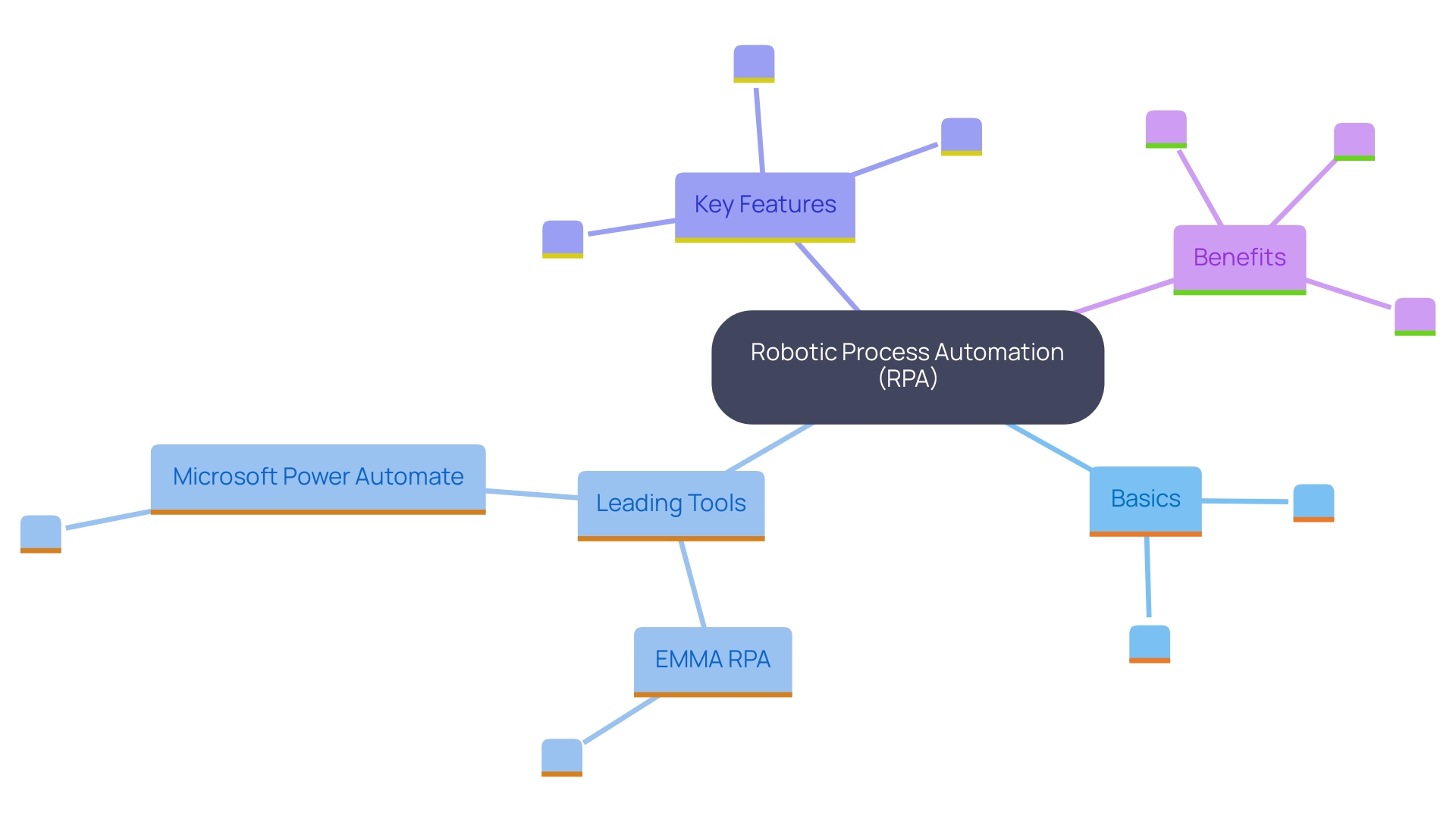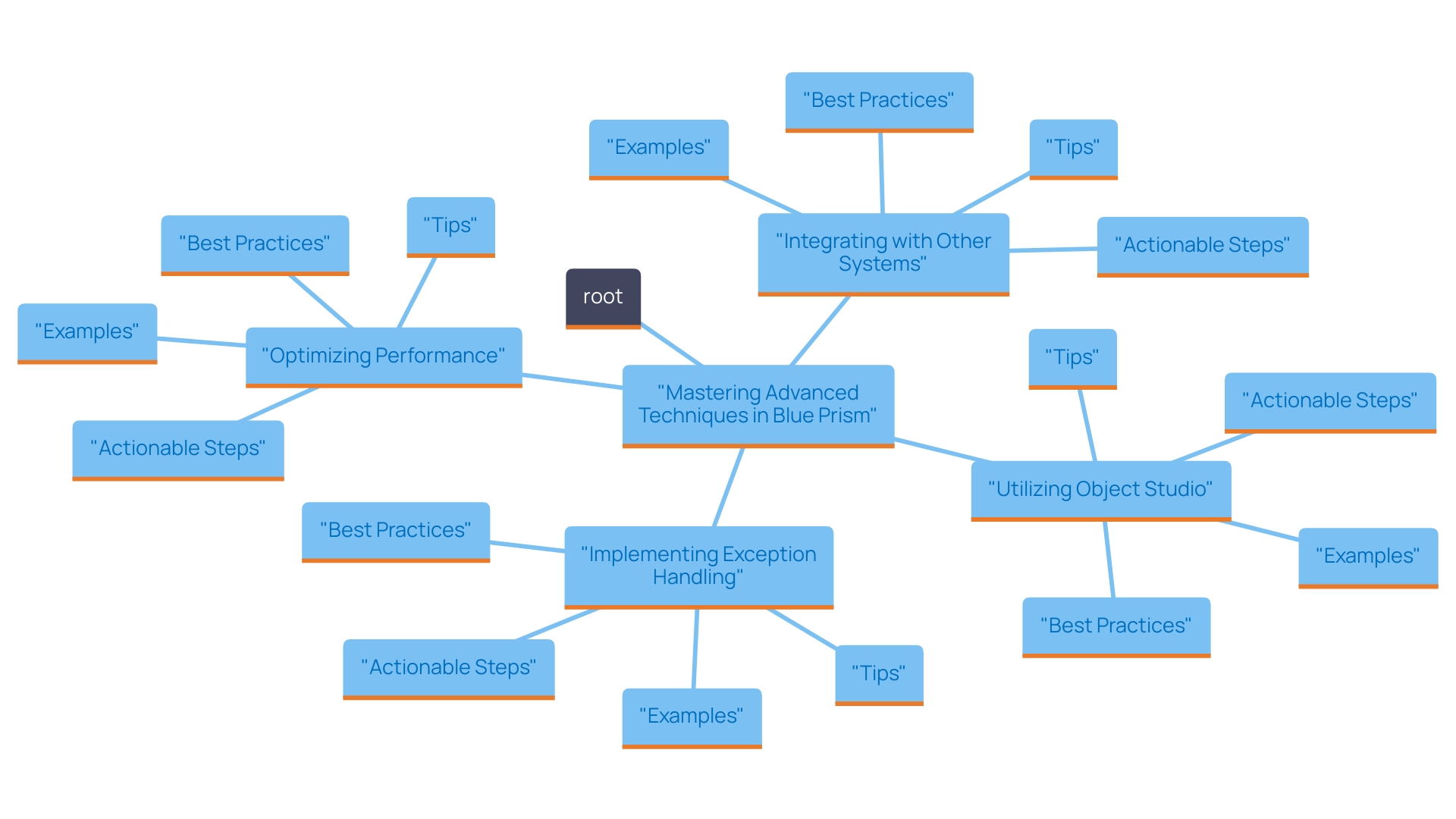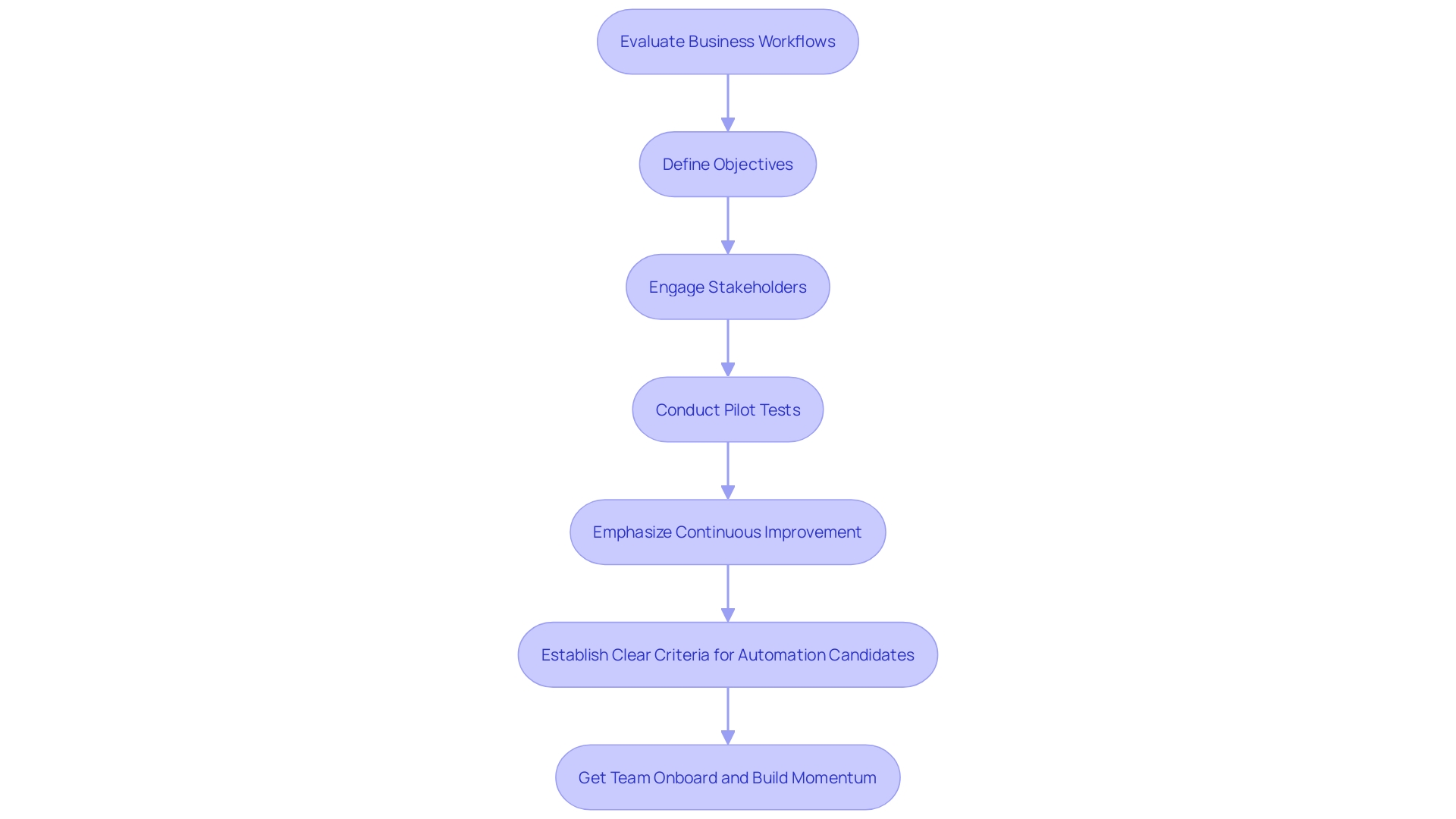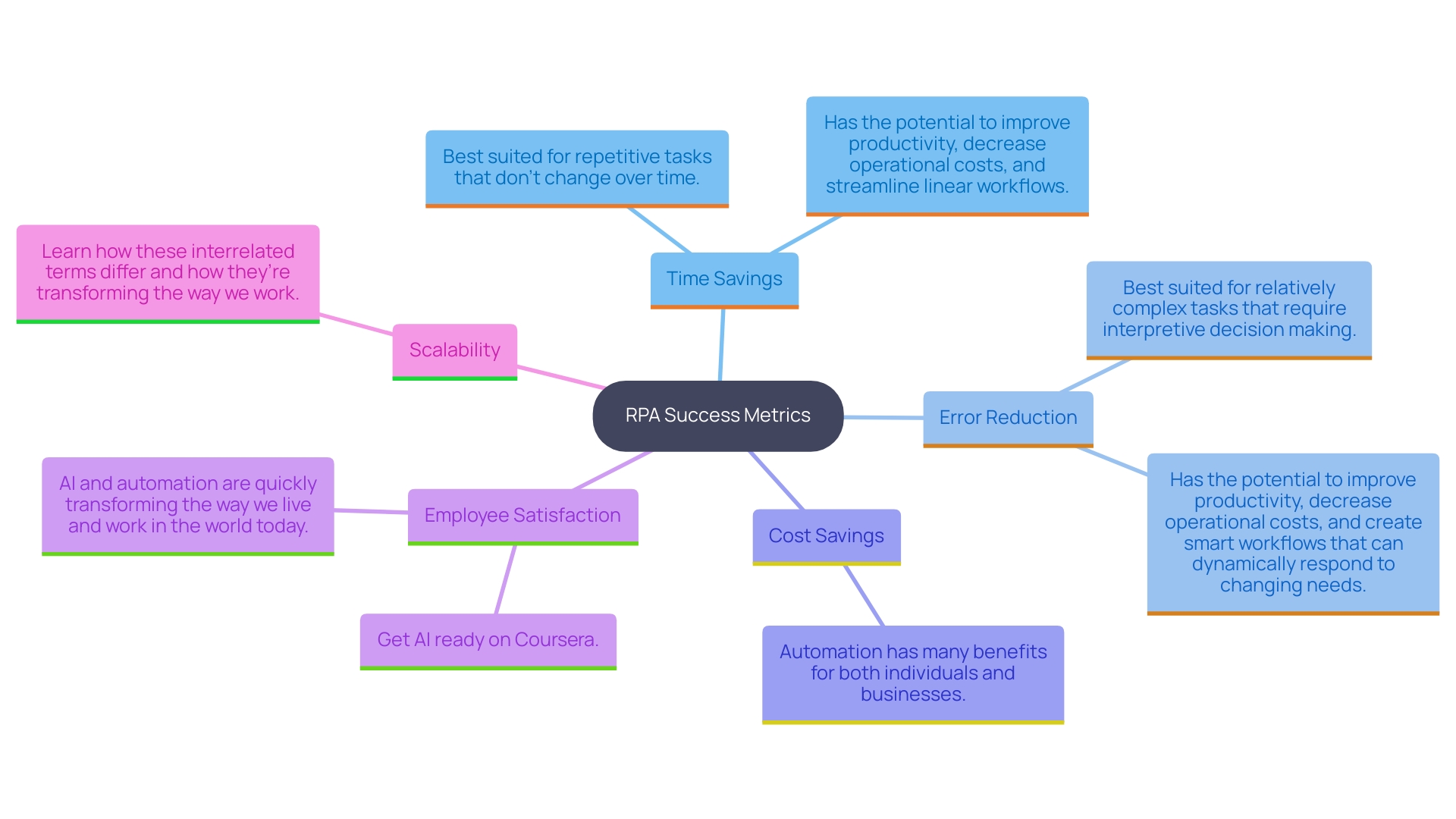Introduction
In the dynamic landscape of business operations, organizations are increasingly turning to Robotic Process Automation (RPA) as a powerful solution to enhance efficiency and reduce operational burdens. With tools like Blue Prism leading the charge, companies can automate repetitive tasks, freeing up valuable human resources for more strategic initiatives. This article delves into the essentials of RPA, exploring foundational concepts, advanced techniques, and the creation of a robust automation strategy.
By understanding how to effectively implement and measure the success of RPA, businesses can unlock significant time and cost savings, while also fostering a more engaged workforce. Join the journey toward operational excellence and discover how RPA can transform the way organizations operate.
Understanding RPA and Blue Prism: A Beginner’s Guide
Robotic Process Automation (RPA) is a technology that utilizes software robots to automate repetitive, rule-based tasks typically performed by humans. Tools like EMMA RPA and Microsoft Power Automate are at the forefront of this innovation, known for their user-friendly interfaces and transformative capabilities. Here’s a brief overview of key concepts:
-
RPA Basics: RPA empowers organizations to automate mundane tasks, significantly reducing human error and enhancing efficiency. It is particularly effective for time-consuming processes such as data entry, invoice processing, and customer support inquiries.
-
Introduction to Leading RPA Tools: EMMA RPA transforms business processes by addressing task repetition fatigue and staffing shortages. In contrast, Microsoft Power Automate allows users to create dynamic automated workflows that seamlessly connect applications and services.
- Key Features of EMMA RPA: A groundbreaking tool for operational efficiency, enhancing productivity through user-friendly digitalization.
-
Key Features of Power Automate: Streamlines workflows, connects apps and data with AI-powered capabilities, and provides accessible solutions for managing processes.
-
Benefits of Using RPA: Implementing RPA leads to significant cost savings, improved accuracy, and enhanced employee morale, as teams are liberated from mundane tasks to focus on strategic initiatives. For instance, companies that have adopted EMMA RPA have reported a 30% reduction in processing times for routine tasks. Leveraging tailored AI solutions alongside RPA further boosts productivity and facilitates informed decision-making, ultimately fueling business growth.

Mastering Advanced Automation Techniques with Blue Prism
In today’s fast-paced business environment, mastering advanced technological techniques is crucial for overcoming operational challenges and enhancing productivity. Once you have a solid grasp of the basics, you can explore advanced techniques in Blue Prism. Here are some key strategies to master:
- Utilizing Blue Prism’s Object Studio: Learn to create reusable objects that define how tasks are automated. This enhances efficiency and decreases redundancy in workflows.
-
Best Practice: Develop a library of objects that can be reused across different workflows to save time and ensure consistency, thereby addressing the challenge of repetitive tasks that can hinder workplace morale and productivity.
-
Implementing Exception Handling: Advanced processes often encounter unexpected situations. Effective exception handling routines are essential for maintaining system integrity.
-
Tip: Utilize Blue Prism’s integrated exception management features to handle errors smoothly and ensure that automated tasks can recover from issues without human intervention, which is essential for addressing staffing shortages and sustaining workflow productivity.
-
Optimizing Performance: Analyze the performance of your automated tasks regularly. Use Blue Prism’s analytics and monitoring tools to identify bottlenecks and optimize workflows.
-
Actionable Step: Conduct regular performance reviews and adjust your automated systems based on data insights to enhance speed and efficiency, echoing the results seen in our case study where operational efficiency improved by 80% through GUI streamlining.
-
Integrating with Other Systems: Explore how Blue Prism can connect with other tools and platforms (such as CRM systems or databases) to create a seamless ecosystem for processes.
- Example: Utilize Blue Prism’s API capabilities to connect with external systems for data exchange and process optimization, enhancing overall operational effectiveness and addressing issues associated with outdated systems that stifle innovation.
By implementing these strategies, your organization can not only enhance operational efficiency but also create a more engaged and productive workforce. The measurable outcomes from our case study illustrate the tangible benefits of these advanced technological techniques.

Creating a Comprehensive Automation Strategy
To create a successful automation strategy using Blue Prism, consider the following steps:
-
Evaluate Business Workflows: Determine which activities are the most suitable for mechanization based on factors such as complexity, frequency, and potential ROI. Our promise is clear: you only pay if we deliver what was promised, as we are confident in our ability to deliver. Utilize mapping tools to visualize and examine workflows, identifying challenges and opportunities for mechanization. Together, we will estimate the time savings and calculate the ROI of the automated process.
-
Define Objectives: Clearly outline the goals of your project, such as reducing processing time or improving accuracy. This will direct your mechanization efforts and help measure success.
-
Engage Stakeholders: Involve essential stakeholders in the planning phase to ensure buy-in and support for your mechanization initiatives. This will help address any resistance to change and foster a culture of collaboration.
-
Pilot Testing: Before large-scale implementation, conduct pilot tests to validate your automated processes. This allows you to refine workflows and address any potential issues. Collect input from users participating in the pilot to make necessary adjustments before implementing the system throughout the organization. Our proven method has assisted clients in decreasing data entry mistakes by 70% and enhancing workflow productivity by 80%.
-
Continuous Improvement: RPA is not a one-time project but a continuous journey. Consistently evaluate and enhance your automation methods to adjust to evolving business requirements and technological progress. By leveraging tailored AI solutions and business intelligence, you can unlock the power of data for informed decision-making, driving growth and innovation.

Measuring the Success of RPA Implementations
To effectively measure the success of your RPA implementations with Blue Prism, it is crucial to consider various metrics that highlight efficiency and effectiveness, particularly in a rapidly evolving AI landscape. Here are key metrics to track:
-
Time Savings: Automating tasks can lead to significant time savings by streamlining operations. For example, a manufacturing company reduced its order processing time by 50% after implementing RPA, allowing teams to focus on strategic tasks that add value.
-
Error Reduction: One of the key benefits of RPA is its ability to minimize human errors, leading to improved data quality. Measure this by comparing error rates in manual versus automated processes. A financial services firm reported a decrease in error rates from 15% to 5% post-automation, maintaining an exception rate below 20% to ensure reliability and accuracy, which is pivotal in the context of Business Intelligence.
-
Cost Savings: Financial benefits are a major driver for RPA adoption. Analyze the reduction in labor costs and the increased capacity to handle more work without additional resources. According to the Institute for Robotic Process Automation and Artificial Intelligence (IRPAAI), RPA solutions can offer a quick saving of 25% to 40% in labor costs. Calculate your ROI by comparing the costs of RPA implementation against the savings achieved, ensuring the investment aligns with your business goals.
-
Employee Satisfaction: By automating tedious tasks, employees can focus on more engaging and strategic work, improving overall morale. Gauge employee satisfaction levels post-automation through surveys to assess their sentiment about workload and job satisfaction. A motivated workforce is essential for the success of any initiative, supporting the goal of enhancing productivity.
-
Scalability: The flexibility of Blue Prism enables swift expansion of initiatives to meet increasing business requirements. Track the quantity of tasks streamlined over time and the simplicity of incorporating new systems into the current framework. Scalability ensures that your solutions can grow with your business, maintaining efficiency and effectiveness.
Additionally, it is essential to keep the margin of error within acceptable limits. The margin of error, a critical metric in RPA, should not exceed 20% to maintain the effectiveness of your automation processes. By adhering to these metrics, you can ensure that your RPA implementations are successful, reliable, and scalable, ultimately leveraging Business Intelligence to transform raw data into actionable insights for informed decision-making.

Conclusion
Embracing Robotic Process Automation (RPA) represents a transformative step for organizations aiming to enhance operational efficiency and reduce the burdens of repetitive tasks. By understanding the foundational concepts of RPA and leveraging advanced tools like Blue Prism, businesses can automate a wide array of processes, resulting in significant time and cost savings. This journey begins with a clear assessment of business processes, defining objectives, and engaging stakeholders to ensure a cohesive approach.
The implementation of advanced techniques, such as effective exception handling and performance optimization, allows organizations to maximize the benefits of automation. By continuously reviewing and refining these processes, businesses can adapt to evolving needs and maintain a competitive edge. Furthermore, employing metrics such as time savings, error reduction, and employee satisfaction provides a comprehensive view of the effectiveness of RPA initiatives, enabling informed decision-making.
Ultimately, RPA is not merely a technological upgrade; it is a strategic initiative that empowers organizations to unlock their full potential. By freeing up human resources from mundane tasks, companies can foster a more engaged workforce focused on strategic initiatives, driving innovation and growth. The time to act is now—embracing RPA will set the foundation for operational excellence and pave the way for a more productive future.
Discover how our tailored RPA solutions can transform your operations today!

